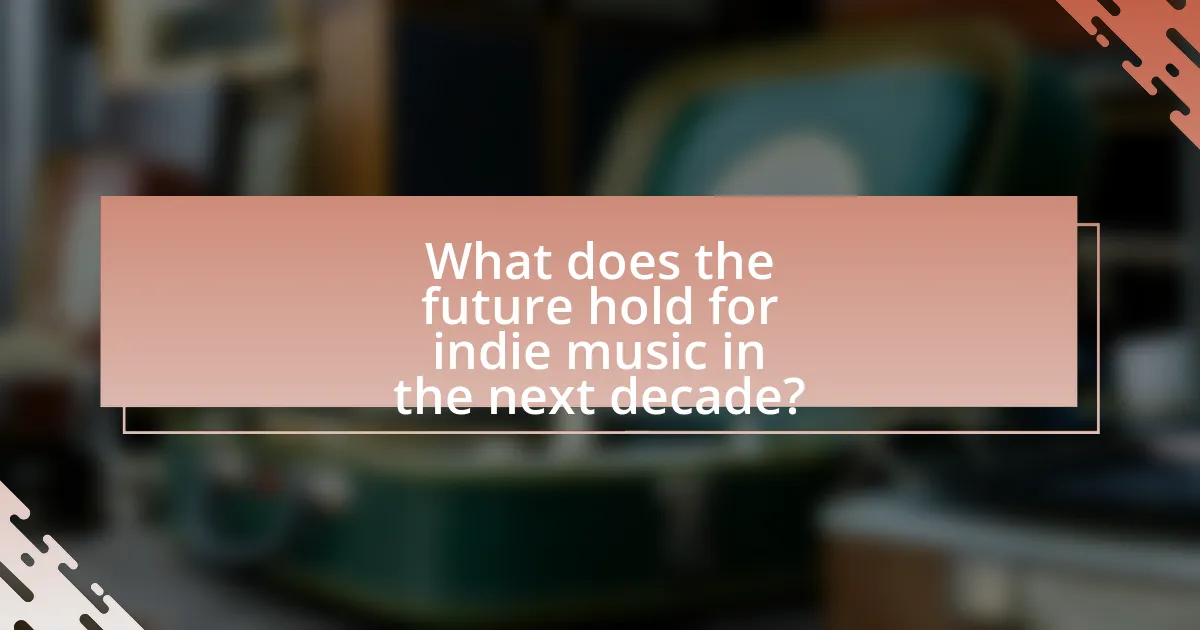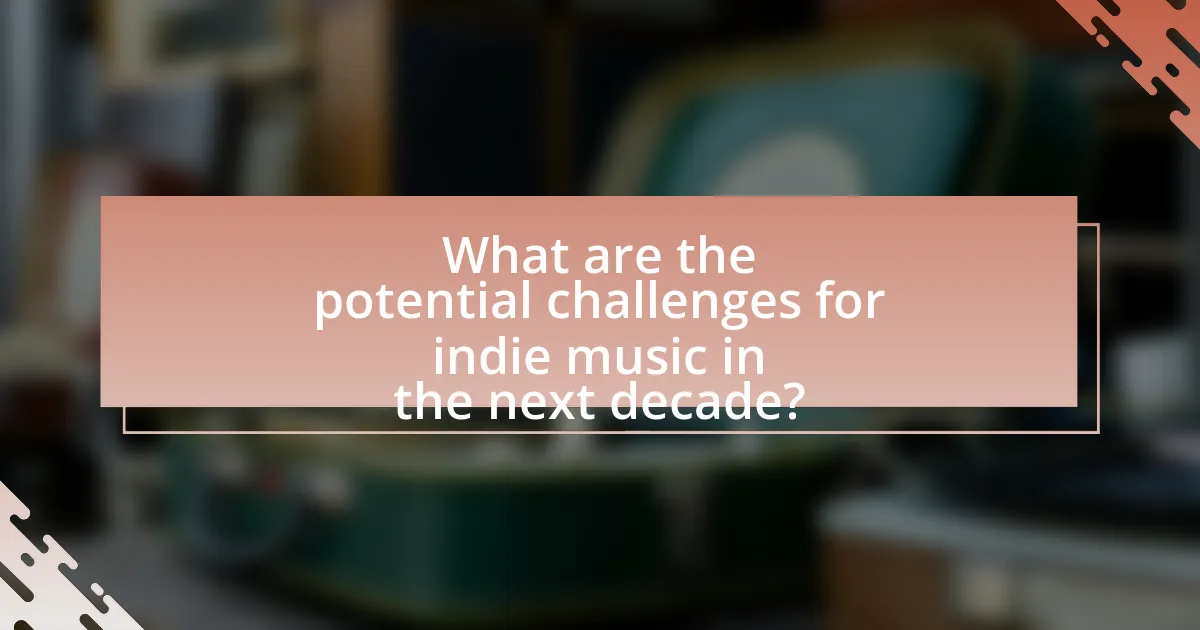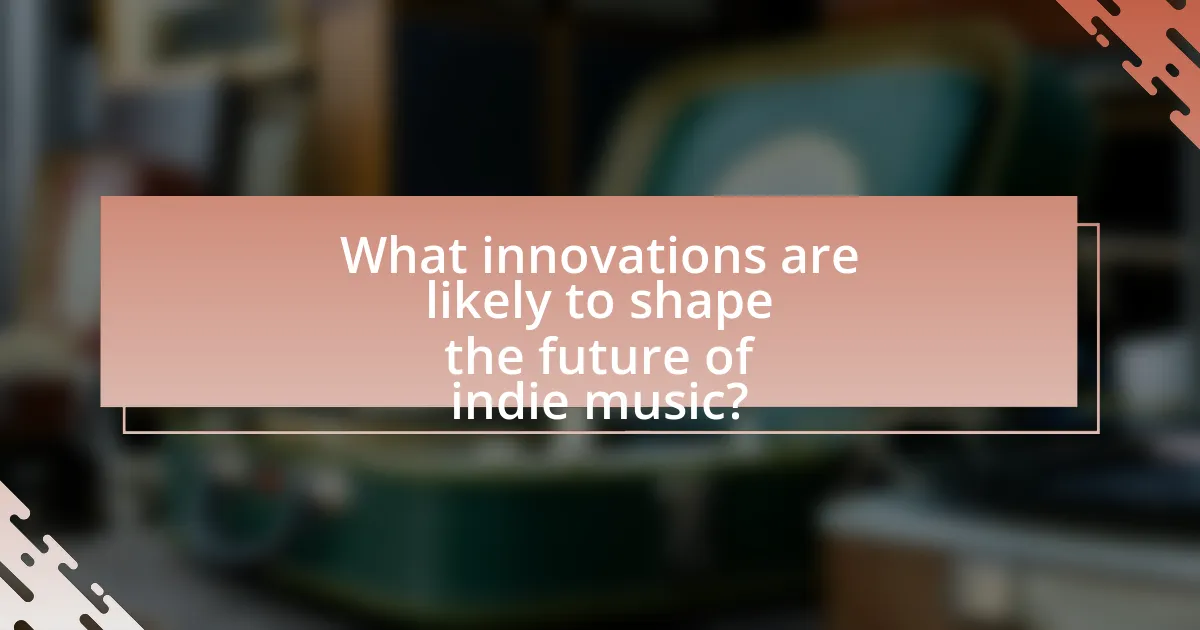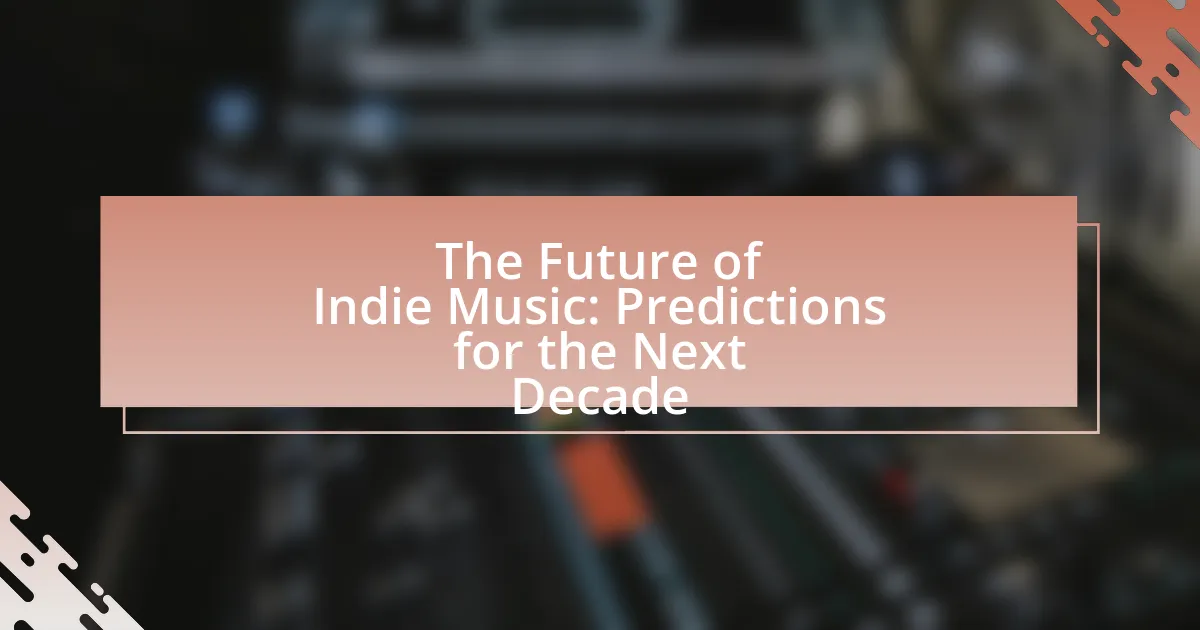The article examines the future of indie music over the next decade, highlighting the anticipated growth in accessibility and diversity driven by technological advancements and changing consumer behaviors. It discusses the evolving indie music landscape, emphasizing the role of streaming platforms, social media, and digital marketing in enhancing artist visibility and audience engagement. Key trends in music production, including the rise of home studios and artificial intelligence, are explored, along with the challenges indie musicians face, such as market saturation and financial instability. The article also addresses the implications of changing music consumption habits and the potential for international collaboration, ultimately outlining best practices for indie artists to thrive in a competitive environment.

What does the future hold for indie music in the next decade?
The future of indie music in the next decade is likely to see increased accessibility and diversity, driven by advancements in technology and changes in consumer behavior. As streaming platforms continue to dominate, independent artists will have greater opportunities to reach global audiences without the need for traditional record labels. According to a report by MIDiA Research, independent music accounted for 40% of global music revenue in 2021, indicating a growing market share that is expected to rise further. Additionally, the use of social media and digital marketing will empower indie musicians to cultivate dedicated fan bases, leading to more personalized and engaging music experiences. This trend suggests that indie music will not only thrive but also evolve into a more integral part of the mainstream music landscape over the next decade.
How is the indie music landscape expected to evolve?
The indie music landscape is expected to evolve towards greater digital integration and diversification of genres. As streaming platforms continue to dominate music consumption, indie artists will increasingly leverage these platforms for wider reach and audience engagement. According to a report by the International Federation of the Phonographic Industry, streaming accounted for 62.1% of global recorded music revenue in 2020, highlighting the importance of digital channels for indie musicians. Additionally, the rise of social media and platforms like TikTok will facilitate viral trends, allowing indie artists to gain exposure rapidly. This evolution will likely lead to a more eclectic mix of sounds and styles as artists experiment with cross-genre collaborations, reflecting the diverse influences available in the digital age.
What trends are emerging in indie music production?
Emerging trends in indie music production include the increased use of home studios, the integration of artificial intelligence in music creation, and a focus on genre-blending. Home studios have become more accessible due to affordable recording technology, allowing artists to produce high-quality music independently. The incorporation of AI tools, such as music composition software, is streamlining the creative process and enabling unique soundscapes. Additionally, genre-blending is gaining popularity as artists experiment with diverse musical influences, reflecting a more globalized music culture. These trends are supported by data indicating a rise in independent music releases, with the number of DIY artists increasing significantly over the past decade.
How will technology influence indie music creation and distribution?
Technology will significantly influence indie music creation and distribution by providing accessible tools and platforms that empower artists. Digital audio workstations (DAWs) and affordable recording equipment enable musicians to produce high-quality music from home, reducing the need for expensive studio time. Additionally, streaming services and social media platforms facilitate direct distribution and marketing, allowing indie artists to reach global audiences without traditional record label support. According to a 2021 report by the International Federation of the Phonographic Industry, independent labels accounted for 40% of global recorded music revenue, highlighting the growing impact of technology on indie music’s market presence.
What role will streaming platforms play in the future of indie music?
Streaming platforms will significantly enhance the visibility and accessibility of indie music in the future. These platforms, such as Spotify and Apple Music, provide independent artists with a global audience, allowing them to distribute their music without the need for traditional record labels. According to a 2021 report by the International Federation of the Phonographic Industry, streaming accounted for 62.1% of global recorded music revenue, demonstrating its critical role in the music industry. This trend indicates that indie artists can leverage streaming services to reach wider audiences, gain traction, and potentially achieve commercial success, thereby reshaping the landscape of indie music.
How are indie artists leveraging streaming services for exposure?
Indie artists are leveraging streaming services for exposure by utilizing playlists, social media integration, and data analytics. Streaming platforms like Spotify and Apple Music allow indie musicians to submit their tracks for inclusion in curated playlists, which can significantly increase their visibility and listener base. For instance, a study by MIDiA Research found that playlist placements can lead to a 30% increase in streams for indie artists. Additionally, these artists use social media to promote their music and engage with fans, driving traffic to their streaming profiles. Data analytics provided by these platforms enable indie artists to understand their audience demographics and tailor their marketing strategies effectively, enhancing their reach and engagement.
What challenges do indie musicians face with streaming platforms?
Indie musicians face significant challenges with streaming platforms, primarily due to low revenue payouts. For instance, a report by the Music Industry Revenue (2021) indicates that artists earn an average of $0.003 to $0.005 per stream, making it difficult for independent musicians to sustain a living solely from streaming. Additionally, the competition on these platforms is intense, with millions of tracks available, which can lead to difficulties in gaining visibility and attracting listeners. Furthermore, indie musicians often lack the marketing resources that major label artists have, limiting their ability to promote their music effectively on these platforms.
How will audience engagement change for indie music?
Audience engagement for indie music will increasingly shift towards digital platforms and personalized experiences. As streaming services and social media continue to dominate, indie artists will leverage these channels to connect directly with fans, fostering a sense of community and interaction. According to a 2022 report by MIDiA Research, 70% of music listeners engage with artists on social media, highlighting the importance of these platforms in building relationships. Additionally, the rise of virtual concerts and live-streaming events allows indie musicians to reach global audiences, enhancing engagement opportunities beyond traditional venues.
What new methods will artists use to connect with fans?
Artists will increasingly use virtual reality (VR) and augmented reality (AR) experiences to connect with fans. These technologies allow for immersive concerts and interactive fan engagements, enhancing the emotional connection between artists and their audience. For instance, platforms like Oculus Venues have hosted VR concerts, enabling fans to experience live performances from their homes, which has been shown to increase fan engagement and satisfaction. Additionally, artists are leveraging social media platforms for real-time interactions, utilizing features like live streaming and Q&A sessions to foster a sense of community and direct communication with fans.
How will social media impact the promotion of indie music?
Social media will significantly enhance the promotion of indie music by providing artists with direct access to their audience and enabling targeted marketing strategies. Platforms like Instagram, TikTok, and Twitter allow indie musicians to share their work, engage with fans, and build a community without the need for traditional record labels. According to a 2021 report by the International Federation of the Phonographic Industry, 70% of music consumers discover new music through social media, highlighting its critical role in music promotion. This direct engagement fosters a more personal connection between artists and listeners, which is essential for indie musicians seeking to establish their brand and grow their fanbase.

What are the potential challenges for indie music in the next decade?
The potential challenges for indie music in the next decade include increased competition from mainstream artists, the dominance of streaming platforms, and difficulties in monetization. As major labels continue to invest heavily in marketing and production, indie artists may struggle to gain visibility. Streaming services, while providing access to a global audience, often favor popular tracks, making it harder for indie musicians to achieve significant playtime. Additionally, the reliance on digital sales and streaming revenue can lead to financial instability, as artists receive a fraction of a cent per stream, which may not cover production and promotional costs. These factors collectively threaten the sustainability and growth of the indie music scene.
How will market saturation affect indie artists?
Market saturation will challenge indie artists by increasing competition and making it harder for them to stand out. As more artists enter the market, the abundance of content can dilute audience attention, leading to difficulties in gaining visibility. According to a 2021 report by MIDiA Research, the number of independent music releases has grown significantly, with over 40% of music consumption now attributed to independent artists. This saturation means that indie artists must invest more in marketing and unique branding strategies to differentiate themselves and capture listener interest.
What strategies can indie musicians adopt to stand out?
Indie musicians can adopt unique branding and targeted social media engagement strategies to stand out. By developing a distinct visual identity and narrative that resonates with their audience, musicians can create a memorable brand. Additionally, utilizing platforms like Instagram and TikTok for direct interaction and content sharing allows for building a loyal fanbase. According to a 2021 report by MIDiA Research, 70% of music discovery now occurs through social media, highlighting its importance in reaching new listeners. Engaging with fans through live streams and behind-the-scenes content further enhances connection and visibility in a crowded market.
How can indie artists navigate the competitive landscape?
Indie artists can navigate the competitive landscape by leveraging digital platforms for distribution and promotion. Utilizing platforms like Spotify, Bandcamp, and social media allows artists to reach wider audiences without the need for traditional record labels. According to a 2021 report by the International Federation of the Phonographic Industry, independent artists accounted for 40% of global music consumption, highlighting the effectiveness of these platforms. Additionally, engaging with fans through live streams and interactive content fosters a loyal community, which is essential for sustaining an indie career in a crowded market.
What financial challenges might indie musicians face?
Indie musicians face several financial challenges, including limited access to funding, high production costs, and fluctuating income streams. Limited access to funding often results from a lack of connections to traditional music industry financing sources, making it difficult for indie artists to secure loans or grants. High production costs, which encompass recording, mixing, and marketing expenses, can strain budgets, especially when artists are self-funding their projects. Additionally, fluctuating income streams arise from reliance on live performances and streaming royalties, which can be unpredictable; for instance, a 2021 report indicated that 70% of musicians reported a significant drop in live performance income due to the pandemic. These factors collectively hinder the financial stability of indie musicians.
How will funding and sponsorship opportunities evolve?
Funding and sponsorship opportunities in indie music will increasingly evolve towards digital platforms and community-driven models. As traditional funding sources decline, artists will leverage crowdfunding and social media to engage fans directly, evidenced by the rise of platforms like Patreon, which reported a 50% increase in creators in 2020. Additionally, brands are shifting their marketing strategies to align with indie artists, as seen in the 2021 Nielsen report indicating that 70% of consumers prefer brands that support local music initiatives. This trend suggests that indie musicians will find more collaborative sponsorship opportunities that resonate with their audience, enhancing both financial support and brand loyalty.
What are the implications of changing music consumption habits?
Changing music consumption habits lead to significant implications for artists, the music industry, and listeners. As streaming services dominate, artists increasingly rely on digital platforms for revenue, shifting the focus from album sales to streaming numbers. This transition has resulted in a decline in physical sales, with vinyl and CD sales dropping by over 80% since the early 2000s, while streaming revenue has surged, accounting for over 80% of the music industry’s total revenue in 2020. Consequently, independent artists face both opportunities and challenges; they can reach wider audiences through platforms like Spotify and Bandcamp, but they must also navigate a landscape where monetization is heavily dependent on streaming algorithms and playlist placements. Additionally, changing habits influence listener engagement, as consumers now favor curated playlists and personalized recommendations over traditional radio, altering how music is marketed and consumed.
How will the global music scene impact indie music?
The global music scene will significantly impact indie music by increasing its accessibility and exposure through digital platforms. As streaming services like Spotify and Apple Music dominate the music industry, indie artists can reach wider audiences without traditional gatekeepers, allowing for greater diversity in music consumption. According to a report by the International Federation of the Phonographic Industry (IFPI), streaming accounted for 62.1% of global recorded music revenue in 2020, highlighting the shift towards digital consumption. This trend enables indie musicians to leverage social media and online marketing, fostering a more interconnected global community that supports niche genres and independent labels.
What opportunities exist for international collaboration?
International collaboration in indie music presents opportunities such as cross-border partnerships, joint music projects, and global distribution networks. These collaborations enable artists to reach wider audiences, share diverse cultural influences, and access new markets. For instance, platforms like Bandcamp and SoundCloud facilitate international exposure, allowing indie musicians to collaborate on tracks and promote their work globally. Additionally, festivals and events like SXSW and Eurosonic Noorderslag encourage networking among artists from different countries, fostering creative exchanges that can lead to innovative music styles and increased visibility.
How can cultural diversity influence indie music trends?
Cultural diversity significantly influences indie music trends by introducing a variety of musical styles, instruments, and lyrical themes that reflect different cultural backgrounds. This infusion of diverse elements allows indie artists to experiment and innovate, leading to unique sounds that resonate with broader audiences. For instance, the incorporation of Afrobeat rhythms or Latin melodies into indie tracks has gained popularity, as seen in the works of artists like Janelle Monáe and Devendra Banhart, who blend genres to create fresh musical experiences. Additionally, cultural diversity fosters collaboration among artists from different backgrounds, resulting in cross-genre projects that push the boundaries of traditional indie music. This trend is supported by the increasing accessibility of global music through digital platforms, enabling indie musicians to draw inspiration from a wider array of cultural influences.

What innovations are likely to shape the future of indie music?
Innovations likely to shape the future of indie music include advancements in digital distribution, artificial intelligence in music creation, and immersive technologies like virtual reality. Digital distribution platforms, such as Bandcamp and SoundCloud, empower independent artists by providing direct access to global audiences, eliminating traditional gatekeepers. Artificial intelligence tools, like OpenAI’s MuseNet, enable musicians to experiment with new sounds and compositions, enhancing creativity and production efficiency. Additionally, immersive technologies, including virtual reality concerts, offer unique experiences that can engage fans in novel ways, as seen in events like the virtual festival hosted by WaveXR. These innovations collectively enhance the accessibility, creativity, and engagement of indie music, positioning it for significant evolution in the coming decade.
How will advancements in technology transform music production?
Advancements in technology will transform music production by enabling more accessible, efficient, and innovative creation processes. Digital audio workstations (DAWs) and artificial intelligence (AI) tools allow musicians to produce high-quality music from home studios, reducing the need for expensive recording facilities. For instance, AI-driven software can analyze music trends and assist in composition, leading to faster production times and unique soundscapes. Additionally, cloud-based collaboration tools facilitate remote teamwork among artists, expanding creative possibilities. According to a report by the International Federation of the Phonographic Industry, the rise of home recording technology has led to a significant increase in independent music releases, demonstrating the profound impact of technological advancements on the music production landscape.
What role will artificial intelligence play in music creation?
Artificial intelligence will play a transformative role in music creation by enabling artists to generate, compose, and produce music more efficiently and creatively. AI algorithms can analyze vast datasets of existing music to identify patterns, styles, and trends, which can then be used to assist musicians in crafting new compositions. For instance, AI tools like OpenAI’s MuseNet and Google’s Magenta have demonstrated the ability to create original music across various genres by learning from extensive musical datasets. This capability not only enhances the creative process but also democratizes music production, allowing independent artists to access sophisticated tools that were previously available only to major studios.
How can virtual reality enhance live indie music experiences?
Virtual reality can enhance live indie music experiences by creating immersive environments that allow audiences to engage with performances in unique ways. This technology enables fans to experience concerts from various perspectives, such as front-row views or backstage access, which traditional venues cannot offer. For instance, a study by the International Journal of Human-Computer Interaction found that VR can increase emotional engagement and presence during live events, leading to a more memorable experience for attendees. Additionally, VR can facilitate virtual meet-and-greets with artists, expanding the connection between musicians and their fans beyond physical limitations.
What new marketing strategies will emerge for indie artists?
New marketing strategies for indie artists will likely include leveraging artificial intelligence for personalized fan engagement and utilizing blockchain technology for transparent revenue sharing. AI tools can analyze listener data to create targeted marketing campaigns, enhancing the connection between artists and their audiences. Blockchain can facilitate direct transactions between artists and fans, reducing reliance on traditional music distribution channels and ensuring artists receive fair compensation. These strategies are emerging as artists seek innovative ways to navigate the evolving music industry landscape, driven by the need for authenticity and direct artist-to-fan relationships.
How can data analytics improve audience targeting for indie music?
Data analytics can significantly enhance audience targeting for indie music by providing insights into listener preferences and behaviors. By analyzing streaming data, social media interactions, and demographic information, indie artists and labels can identify specific audience segments that are most likely to engage with their music. For instance, platforms like Spotify and Apple Music offer analytics tools that reveal which songs are popular among different age groups and geographic locations, enabling targeted marketing strategies. Additionally, a study by Nielsen Music found that 70% of music listeners are influenced by personalized recommendations, highlighting the effectiveness of data-driven approaches in reaching the right audience.
What innovative approaches can artists take to crowdfunding?
Artists can adopt several innovative approaches to crowdfunding, such as utilizing social media platforms for direct engagement, offering tiered rewards that enhance fan experience, and leveraging blockchain technology for transparency and security. Social media allows artists to build a community and create buzz around their projects, which can lead to increased funding. For instance, artists can host live-streamed events or Q&A sessions to connect with potential backers. Offering tiered rewards, such as exclusive content or personalized experiences, incentivizes higher contributions and fosters a deeper connection with supporters. Additionally, blockchain technology can provide a secure and transparent way to manage funds, ensuring that backers can track how their contributions are used, which can enhance trust and encourage more significant investments. These methods have been shown to increase engagement and funding success rates in various crowdfunding campaigns.
What are the best practices for indie musicians in the coming decade?
Indie musicians should prioritize building a strong online presence and engaging with their audience through social media platforms. This approach is essential as data shows that 70% of music discovery now occurs online, highlighting the importance of digital marketing strategies. Additionally, musicians should focus on diversifying their revenue streams by exploring merchandise sales, crowdfunding, and live streaming performances, as these methods have proven effective in sustaining income for independent artists. Collaborating with other artists and leveraging platforms like Bandcamp and Patreon can further enhance visibility and financial support, aligning with the trend of community-driven music consumption.
How can indie artists effectively build their brand?
Indie artists can effectively build their brand by leveraging social media platforms to engage directly with their audience. Utilizing platforms like Instagram, TikTok, and Twitter allows artists to showcase their personality, share behind-the-scenes content, and connect with fans in real-time, which fosters a loyal community. According to a 2021 report by the International Federation of the Phonographic Industry, 70% of music consumers discover new artists through social media, highlighting its critical role in brand building. Additionally, collaborating with other artists and influencers can expand reach and introduce indie artists to new audiences, further solidifying their brand presence in the competitive music landscape.
What tips can help indie musicians thrive in a changing industry?
Indie musicians can thrive in a changing industry by embracing digital platforms for distribution and promotion. Utilizing streaming services like Spotify and social media channels such as Instagram and TikTok allows artists to reach wider audiences without the need for traditional record labels. According to a 2021 report by the International Federation of the Phonographic Industry, streaming accounted for 62.1% of global recorded music revenue, highlighting the importance of digital presence. Additionally, building a strong personal brand and engaging directly with fans through live performances and virtual events fosters loyalty and community support, which are crucial for sustained success in the evolving music landscape.

![Exploring the Lyrics: Themes and Inspirations in [Band Name]’s Discography](https://therooksband.com/wp-content/uploads/Featured-image-Exploring-the-Lyrics-Themes-and-Inspirations-in-Band-Names-Discography-150x150.webp)
![Collaborations and Features: [Band Name]’s Most Notable Partnerships](https://therooksband.com/wp-content/uploads/Featured-image-Collaborations-and-Features-Band-Names-Most-Notable-Partnerships-150x150.webp)